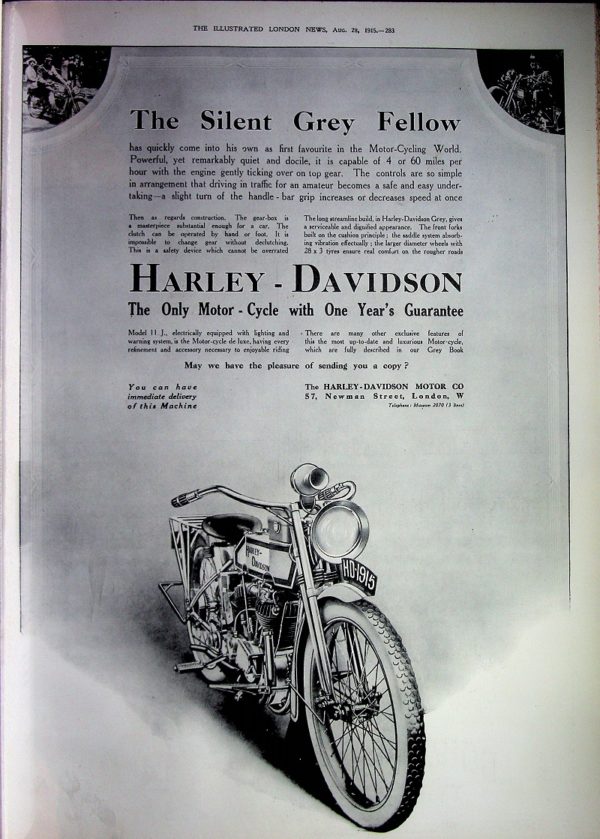
The Harley-Davidson is so well known today that perhaps we forget its early history – and its story in Britain. This advertisement appeared in The Illustrated London News on August 28, 1915, in the middle of World War I. America was not yet at war, but Harley-Davidson were already advertising their products in Britain.
in 1917, the United States entered World War I and the military demanded motorcycles for the war effort. The U.S. military purchased over 20,000 motorcycles from Harley-Davidson, and messengers on motorcycles became a more familiar sight than those on horseback.
Harleys may have been sold in Britain at this time, but there is no sign that they were bought by the British army. That honour fell to the Triumph Model H used for the same communications task. And the Triumph had one development that Harley did not: it was the first Triumph not to be fitted with pedals. The Harley in our picture still has those archaic accessories.
The Harley-Davidson company was founded in 1903 in Milwaukee, Wisconsin. In 1901, 20-year-old William S. Harley designed a small engine with a displacement of 116 cc for use in normal pedal-bicycle frame. Over the next two years, he and his friend Arthur Davidson worked on their motor-bicycle, and by they had created a machine with an advanced loop-frame pattern and a larger engine that took it beyond the motorised bicycle and became the forerunner of future motorcycle designs. They were also helped in their engine design by outboard motor pioneer Ole Evinrude, then already building petrol engines of his own design in Milwaukee.
By April 1905 they were producing complete motorcycles on a very limited basis. 50 were made in 1906 and production increased to 150 motorcycles in 1907.
The motorbikes in 1905 and 1906 were all single-cylinder models with 440-cc engines. In February 1907, they displayed a prototype model at the Chicago Automobile Show with a 45-degree V-Twin engine displacing 880 cc and producing about 7 horsepower. This gave about double the power of the first singles, and top speed was about 60 mph. Production jumped from 450 motorcycles in 1908 to 1,149 machines in 1909.
In 1911, the company introduced an improved V-Twin model with a displacement of 811 cc and mechanically-operated intake valves, giving more power from reduced capacity.
The 1915 model in our Snapshot was a significant step forward for Harley-Davidson. It combined some traditional aspects, such as the slab petrol tank and the pedals, with modern features such as a three-speed countershaft gearbox, electric lighting and, in the wording of this advertisement, ‘warning system’ (an electric horn!).
The other big news for the 1915 Harley-Davidson models was the upgraded, 11-hp V-twin engine, now with a mechanically driven oil pump and thus improved reliability. Perhaps this is what enabled Harley-Davidson to give a one-year guarantee. If the advertisement is to be believed, this was unique in Britain at the time. It is to be hoped that this convinced at least some British riders to buy.
Picture courtesy of the Richard Roberts Archive







Leave a Comment